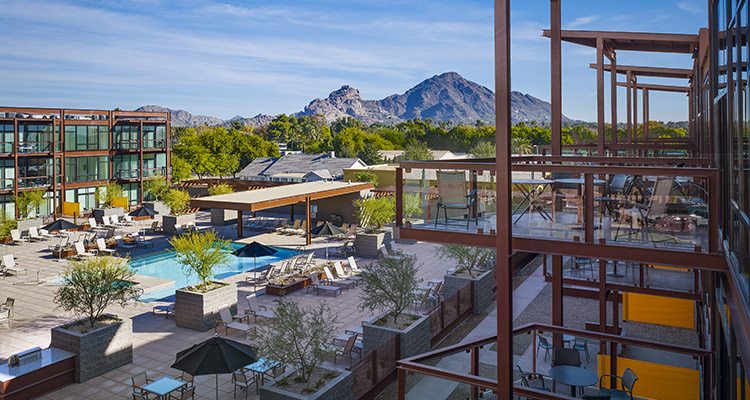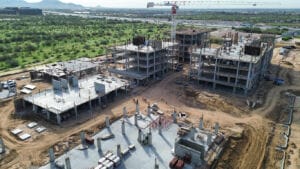 The future of Phoenix is looking packed, as it is expected to need 150,302 new apartment units by 2030 to keep up with demand, according to a study released in late June.
The future of Phoenix is looking packed, as it is expected to need 150,302 new apartment units by 2030 to keep up with demand, according to a study released in late June.
Phoenix will need to add 10,736 apartment units per year on average in the coming years to meet this projected demand, according to a study released by the Arizona Multihousing Association (AMA) and National Apartment Association (NAA).
The Phoenix area’s accelerating population growth, a rising number of Baby Boomers opting for the lock-and-leave lifestyle that apartments offer and Millennials staying in apartments longer are fueling this expected demand, says Courtney Gilstrap LeVinus, interim president and CEO of AMA.
“I think people are generally surprised there is such a need (for apartments),” Gilstrap LeVinus says. “When you go in and look at the numbers, and really recognize the demographic shift that we’re seeing, it starts to make sense.”
Arizona is also growing, especially Maricopa County. In March, the U.S. Census Bureau announced that Maricopa County was the fastest growing county in the country last year, adding 222 people per day.
To meet this projected demand, it looks like Phoenix-area developers will have their work cut out for them.
Currently, Colliers International is forecasting that about 10,500 apartments will come online this year in Metro Phoenix. That number is up from the average of about 6,300 apartment units per year from 2014 to 2006, says Pete O’Neil, research director at Colliers International’s Phoenix office. But 2017’s projections will likely hit a 30-year high for the market, he adds.
For this year, it looks like Phoenix is on track to meet the report’s projected demand, but that might not be the case going forward.
“I would be very surprised if this level of new construction is able to be sustained in the next few years,” O’Neil says.
 Although it’s too early to come up with a 2018 forecast, Colliers has its eye on about 5,000 apartment units that are under construction right now that will be move-in ready next year, O’Neil says.
Although it’s too early to come up with a 2018 forecast, Colliers has its eye on about 5,000 apartment units that are under construction right now that will be move-in ready next year, O’Neil says.
The AMA report also notes that apartments of all types will need to be built to meet this projected demand.
There could be a problem with meeting the full needs of the projected demand. The current trend when it comes to new apartment developments is luxury, amenity-rich assets in urban communities.
“Many of the new developments are mid-rise, in popular submarkets with amenities in the complex with nearby dining and entertainment options,” O’Neil says. “The average rent in new construction is 40 to 50 percent higher than the current average market rent. Affordable and mid-range are not a large segment of new construction.”
The demographic shifts that the AMA is seeing might not make this so much of a problem, though. Retiring Baby Boomers who may be selling their homes for an apartment will have cash to spare for these amenity-rich communities.
Meanwhile, Millennials are getting married much later in life, and aren’t moving into single-family homes as young as previous generations, Gilstrap LeVinus says. And everyone knows how much Millennials love easy, amenity-rich types of apartments that are within urban cores, which is where many of these luxury apartment developers are cropping up.
Gilstrap LeVinus says the AMA is certainly seeing the national trend of urbanization where many generations are leaving the suburbs for downtown regions.
“People don’t want to be in their car at the beginning of the day, or the end of the day for a couple of hours,” she says. “They want to be close to amenities, being in the same area as the neighborhood.”
What could stop us?
The Multihousing Association’s national report calls for more incentives to be created and for restrictions to be loosened in order to help developers meet this demand.
Arizona has a healthy climate for apartment developers, Gilstrap LeVinus says. “We’re still able to build very affordable units, because our land costs are not what we see in other urban cities,” she notes.
There is still a desire to move projects along faster, she mentions, “Anything that we can do to work with municipalities to get projects to the finish line, without shortcuts is critical.”

Developers looking to fill this expected demand will need to find a balance of creating projects quickly while bringing lasting assets to the Phoenix area.
There are tools that exist to strike that balance of fast pace projects with no shortcuts. The City of Phoenix has a program that allows developers to use city-approved third-party certification.
“Architects and engineers can certify the plan, so (developers) don’t have to go through every single step with the City of Phoenix,” Gilstrap LeVinus says. She mentions several local Multihousing Association members have taken advantage of Phoenix’s program to get projects moving at a faster rate.
“Again, it’s striking that balance to make sure that all of the i’s are dotted, t’s are crossed, neighborhoods are happy with the development that’s going in, and the project goes through the process as it should,” she says.
Is meeting this demand possible?
Meeting this apartment demand is going to be a challenge, Gilstrap LeVinus says. A lot of the developments that will meet this demand are being built in the Valley’s urban cores, like Downtown Phoenix, Gilstrap LeVinus explains, but we could start seeing apartments spread out to other regions, like the West Valley and rural Arizona.
Job growth in the state and in the Valley is very important to whether or not this demand will even exist. The AMA is tied with the Arizona Commerce Authority and other organizations when it comes to working to bring more jobs to the state, Gilstrap LeVinus says. More jobs, means more apartments, she adds.
And it’s very important to businesses that may move operations here that there is adequate housing at all economic levels for employees, Gilstrap LeVinus says.

Annual job growth is the most correlated metric to annual apartment demand, says John Carlson, president at Mark-Taylor Residential, which operates more tha $2.5 billion in multifamily real estate investments.
According to Mark-Taylor Residential’s analysis, the Valley is approaching the middle point of the current multifamily expansion, he says.
The apartment market has remained in balance this cycle, when job growth from 2011 to the present and historical absorption are taken into account, Carlson says.
Looking ahead, it remains to be seen if adding 150,302 new apartment units by 2030 to meet expected demand will be a reality.
“We all know that job growth and therefore apartment construction are not linear, they are cyclical and based largely on unpredictable factors like monetary policy and the availability of debt,” Carlson says. “With that said, looking ahead and in consideration of that cyclicality, our best estimate would be that approximately 55,000 to 70,000 new apartment units are built from 2018-2030.”




